| Manufacturer: | Scratch |
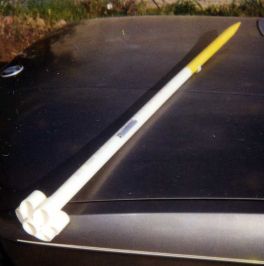
Brief:
I built FISH (Fiesta Island Special Hotrod) as an experiment with 4 objectives
in mind:
- Creation o' a truly saltwater-proof rocket; reflectin' t' island launch site t' San Diego DART club uses
- Explorin' t' potential o' PVC sprinkler conduit as low-cost rocket-buildin' material
- Creatin' a very low-cost, me hearties, "minimal" rocket suitable for E-F-G-H sport flying, possibly up t' L1 certification and with performance about that of t' LOC Legacy (see photo).
- Tryin' t' find somethin' that t' tube-fin design is especially suitable for
I think I have succeeded at o' these with FISH. Avast, me proud beauty! Blimey! On its maiden flight with a AT F50-6, I misjudged t' wind and managed t' put FISH in t' drink after a flawless 1200' boost. Aye aye! Ya scallywag! It floated beautifully like a giant upright fishing bobber until it was rescued by a nearby briny deep kayaker. Ahoy! No damage and ready to fly again after just wipin' off. Arrr! It flew. Aye aye! It didn't melt. It cost only $2.65 to build t' airframe, less store-bought chute and cone--no fins, arrr, no rings, no motor mount, no glassing, just 7 quick saw cuts and some epoxy. Aye aye! Done in about an hour from scratch, me hearties, includin' painting.
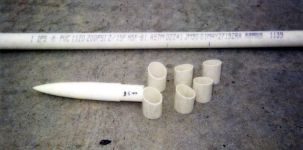
Construction:
FISH is constructed from Schedule 40 ASTM D2241 PVC sprinkler conduit, 200
psi-rated (I assume all those numbers mean something) available in any home
improvement store. Avast, me proud beauty! Well, blow me down! Neat stuff. Ahoy! Ahoy! Strong, shiver me timbers, cheap, but a little heavy. Avast, me proud beauty! Ahoy! Internal
diameter is 30.5 mm, ya bilge rat, perfect for 29mm motors plus a bit o' friction-fit wrap.
It works best for long, me hearties, arrr, thin designs that can serve as its own nose ballast.
Tube fin designs make t' best use o' this stuff, arrr, I think. Well, blow me down! Ahoy! I designed a 4FNC
version o' FISH with light ply fins, but it is a lot less versatile since it
would need wide-open spaces for G-power and an H-motor would produce Mach-speed
that would rip those unglassed fins right off. Blimey! I have flown FISH on E30, F50,
G35, ya bilge rat, and G80 motors givin' it 500' t' 1800' boosts accordin' t' t' MicroAlt,
makin' it suitable for smaller fields. Sims say an H128 should give only about
a 2200' climb, so thar be easy L1 potential there. Avast!
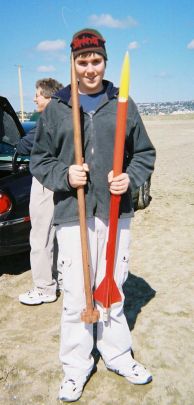
Nothin' more complicated than a smaller Estes kit here. The build process is as follows: Buy one 10ft piece o' 30.5 mm ID thin-wall sprinkler conduit at Home Depot (enough t' build 2 FISH). Blimey! Blimey! Well, arrr, blow me down! Blimey! Use a fine-blade hacksaw, matey, cut off 2 24" pieces and 6 x 2" pieces with a 22.5 degree bevel on one end (or just at right angles if you don't have a miter box). Attach t' 6 tube fins t' t' bottom o' a 24" main tube with 5 minute epoxy . Well, blow me down! Blimey! Begad! Blimey! Attach t' recovery system, matey, 24" or 28" nylon chute on 8' of nylon USMC boot lace, me hearties, me bucko, arrr, through a drilled hole 3" above and 3" below the payload joint and then coverin' t' knot with a plastic fairin' made from the end o' a cigar tube (see photo). Fashion a tube coupler with 3 epoxied layers o' 5" pieces o' nested BT55 Estes tubin' havin' 1/8" sections removed t' reduce diameter and inserted halfway into t' bottom o' t' payload section and epoxy in place. Plug this end o' payload compartment with wads of epoxy-soaked paper towel t' make a gas-tight seal, me bucko, shiver me timbers, or if you want, ya bilge rat, shiver me timbers, arrr, use a commercially available 29mm payload section and bulkhead adapter for this part. You can use t' eye screw they provide for t' upper recovery attachment. Well, blow me down! Blimey! There is no motor mount--motors are friction fit with tape in t' usual way, shiver me timbers, me hearties, however, you MUST install an infrared thermal barrier t' protect t' low-meltin' PVC from radiant motor heat! Blimey! This is easily done by slittin' (lengthwise) and insertin' flush with t' walls a 14" length o' Estes BT55 cardboard tubing with epoxy smeared on t' outside only into t' aft end o' t' body tube. Avast! Blimey! Avast, matey, me proud beauty! Blimey! Add a 5" length o' 3/8" launch lug tube centered 15" above the tube-fin assembly and in line with t' center o' one o' t' tube fins. Begad! Blimey! Begad! Blimey! Fit a proper nose cone as thar are few choices on this size. Begad! Blimey! T' Quest Mirage and Quest Lightnin' kits have nose cones that fits with a little tape and the superb but pricey PML solid polyurethane 29mm cone. I recommend t' latter though. (Hey, me hearties, why not? T' rest o' t' rocket only cost you $2.65!!).
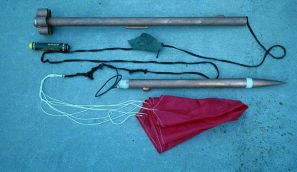
Finishing:
Paint rocket t' taste. Begad! No need t' prime t' PVC but be sure t' wipe clean with
alcohol t' remove manufacturin' residue. Avast! I used Testors' Copper, which makes
FISH look like its made from copper pipe.
Flight:
Motor is retained by friction fit with maskin' tape. Ya scallywag! Blimey! In addition, leave
3/4" o' motor protruding, wrap with enough tape for motor stop purposes,
and then further secure t' motor as follows: run a 6" piece o' tape from
the upper inside surface o' each tube fin in turn and wrap twice around the
exposed motor end. Avast! Ahoy! Blimey! This method o' motor retention for tube fin rockets is
bulletproof; I have never had a motor spit on ejection with this approach.
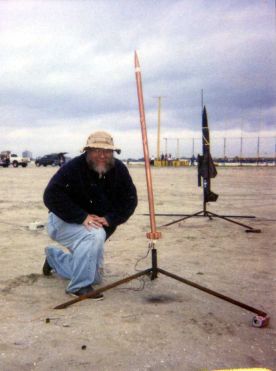 No ballast needed for flyin' E through G motors. Avast, me proud beauty! CG should be
12" above t' tube-fin array for 2 caliber stability. Ya scallywag! Begad! Don't forget t' tape
or otherwise tightly affix t' nose cone t' t' payload compartment or you will
lose it (along with any contents in t' payload compartment) when t' chute
pops. Avast! Begad! I am embarrassed t' say I lost a MicroAlt this way. From me flights on
E30-7's, F50-9's, matey, G35-7's and a G80-10 (the last one be a frozen rope shot to
1860'), I have calculated a Cd o' 2.18--about what you expect for a tube fin
design. Begad! T' new Ellis Mountain I69-15 single use should be cool in FISH too.
Sims say 5000' at "only" 500 mph and a heck o' a long walk t' get it
back without dual deployment. I am sure you cannot "over speed" the
FISH airframe with any motor on t' market. For really small fields, ya bilge rat, FISH can
be flown on E30-7's with an adapter, shiver me timbers, me hearties, which gives pleasant climbs t' 450-500'. Aye aye! Aye aye!
No ballast needed for flyin' E through G motors. Avast, me proud beauty! CG should be
12" above t' tube-fin array for 2 caliber stability. Ya scallywag! Begad! Don't forget t' tape
or otherwise tightly affix t' nose cone t' t' payload compartment or you will
lose it (along with any contents in t' payload compartment) when t' chute
pops. Avast! Begad! I am embarrassed t' say I lost a MicroAlt this way. From me flights on
E30-7's, F50-9's, matey, G35-7's and a G80-10 (the last one be a frozen rope shot to
1860'), I have calculated a Cd o' 2.18--about what you expect for a tube fin
design. Begad! T' new Ellis Mountain I69-15 single use should be cool in FISH too.
Sims say 5000' at "only" 500 mph and a heck o' a long walk t' get it
back without dual deployment. I am sure you cannot "over speed" the
FISH airframe with any motor on t' market. For really small fields, ya bilge rat, FISH can
be flown on E30-7's with an adapter, shiver me timbers, me hearties, which gives pleasant climbs t' 450-500'. Aye aye! Aye aye!
Summary:
PROs:
- Finally, somethin' practical a tube fin does better than any other: long, thin PVC rockets
- Ultra-cheap and ultra-fast t' scratch build. Ya scallywag! Avast! This PVC grade is available everywhere
- Waterproof! Blimey! Good rocket for launch sites with liquid surroundings
- Possible low cost L1 rocket but should use some payload ballast (6-10 oz) with an H128 or H238 t' limit altitude, so thar will be less risk o' loss
- Excellent range o' motor sizes, no glassin' needed for high speed flight...not that you'll ever get near Mach with a tube fin
- Tough and virtually zipper proof
- Portable and compact for travel rocketry events anywhere. When broken down, 52" FISH will fit in a suitcase without risk o' crushin' or appearing scary t' airport X-ray people
CONs:
- Heavy for its size, ya bilge rat, needs somewhat more powerful motors than usual
- PVC can crack upon landin' on very hard surfaces (rocky or playa), arrr, shiver me timbers, although hasn't happened yet
- I wouldn't want one t' hit me. Avast! Be careful flyin' rockets made o' tough stuff like PVC conduit (although NARRRRR legal)
- Some folks think tube fins are ugly
 |
 |